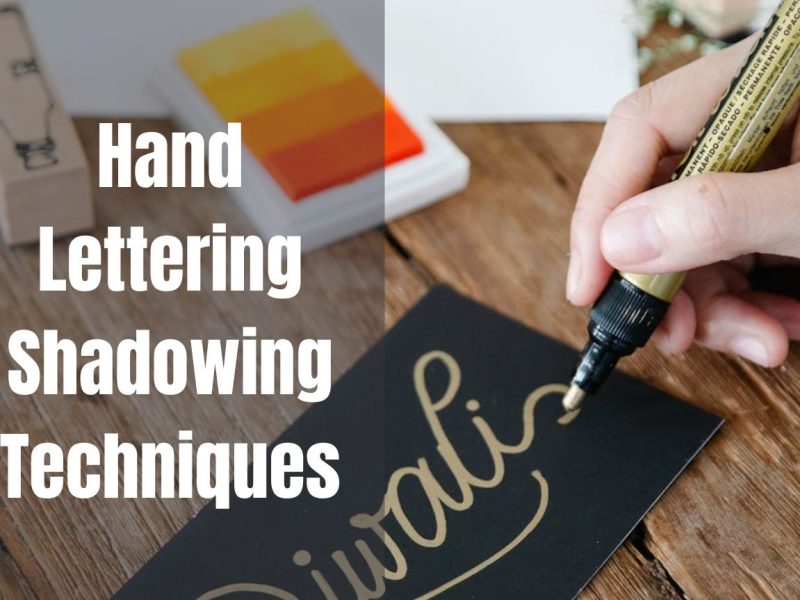Hand lettering is an art form that involves creating letters, words, and designs using various writing tools. It’s a versatile craft enjoyed by professionals, artists, and hobbyists alike. To produce beautiful and consistent lettering pieces, having the right tools is crucial. In this comprehensive guide, we’ll explore the essential hand-lettering tools you need to elevate your craft.
Essential Hand Lettering Pens and Markers
Types of Pens and Markers
Brush Pens
Brush pens are a popular choice for hand lettering due to their flexibility and ability to create varying line widths. These pens have a flexible brush-like tip that allows for thick downstrokes and thin upstrokes, mimicking the effect of traditional calligraphy.
- Tombow Dual Brush Pens: These pens feature a flexible brush tip on one end and a fine tip on the other, making them versatile for both lettering and adding details.
- Pentel Touch Sign Pen: Known for their juicy ink flow and smooth stroke, these pens are perfect for creating bold, expressive lettering.
- Copic Sketch Markers: While primarily used for illustration, Copic Sketch Markers offer a wide range of colors and can be used for hand lettering, especially for adding vibrant accents and color blending.
Fine-liners
Fine liners are essential for creating precise, consistent lines and adding intricate details to your lettering pieces. These pens have a sturdy, fine-tipped nib and are available in various tip sizes.
- Micron Pigma Pens: With their archival-quality, waterproof ink and a range of nib sizes, Micron Pigma Pens are a go-to choice for intricate lettering and illustrations.
- Sakura Pigma Sensei Pens: These pens feature a comfortable grip and a precision-crafted metal nib, making them ideal for detailed lettering and drawing.
- Copic Multiliner Pens: Copic Multiline Pens offer a variety of tip sizes and colors, allowing you to create intricate designs and add vibrant accents to your lettering pieces.
Calligraphy Pens
Calligraphy pens are designed to mimic traditional dip pens, providing a classic calligraphic look to your lettering. These pens feature a reservoir of ink and a flexible nib that creates thick and thin lines with varying pressure.
- Pilot Parallel Pens: With their unique parallel plate design, these pens produce consistent line widths and are perfect for beginners and experienced calligraphers alike.
- Speedball Calligraphy Pen Set: This set includes various nib sizes and styles, making it ideal for exploring different calligraphic scripts and techniques.
- Manuscript Calligraphy Pen Set: Featuring high-quality nibs and a convenient cartridge system, these pens offer a smooth writing experience and are great for both practice and final pieces.
Factors to Consider When Choosing Pens and Markers
- Ink Quality: Look for pens and markers with waterproof, archival, and bleed-resistant ink to ensure your lettering pieces are long-lasting and vibrant.
- Nib Sizes and Tip Variations: Consider the range of nib sizes and tip variations available to suit your lettering style and project requirements.
- Ergonomic Grip and Comfort: Comfort is key when working on long lettering projects, so choose pens and markers with ergonomic grips that fit your hand comfortably.
- Price Range and Value for Money: Hand lettering tools can vary in price, so consider your budget and look for high-quality options that offer good value for money.
Essential Hand Lettering Papers and Surfaces
Types of Papers and Surfaces
Smooth Drawing Papers
Smooth drawing papers provide a consistent surface for creating clean, precise lettering pieces.
- Hot Press Watercolor Paper: This smooth, lightweight paper is ideal for pen and marker work, as it minimizes bleed and feathering.
- Marker Pads: Specifically designed for markers and inks, these pads offer a smooth surface and bleed-resistant pages.
- Bristol Board: Known for its smooth surface and durability, Bristol board is a popular choice for lettering and illustration projects.
Textured Papers
Textured papers can add depth and character to your lettering pieces, creating unique and visually appealing effects.
- Cold Press Watercolor Paper: With its slightly textured surface, cold press watercolor paper can create interesting effects with brush pens and calligraphy inks.
- Mixed Media Paper: As the name suggests, mixed media paper is designed to work well with various media, including pens, markers, and paints.
- Calligraphy Paper: Specifically designed for calligraphic work, calligraphy paper features a subtle texture that enhances the beauty of your lettering.
Non-paper Surfaces
Expand your creativity and explore lettering on unique surfaces beyond traditional papers.
- Chalkboards: Chalkboards offer a versatile and erasable surface for practicing lettering or creating temporary displays.
- Glass: Smooth glass surfaces can be used for lettering with chalk markers or window crayons, creating stunning window displays or temporary signage.
- Wood: Lettering on wood surfaces can add a rustic and natural touch to your projects, perfect for home decor or signage.
Factors to Consider When Choosing Papers and Surfaces
- Tooth and Texture: The tooth and texture of the paper or surface can greatly impact the appearance and feel of your lettering. Consider the desired effect and choose accordingly.
- Bleed Resistance: Opt for papers and surfaces that are bleed-resistant to prevent ink from spreading or feathering, especially when using markers or brush pens.
- Opacity and Transparency: Depending on your project, you may want an opaque or transparent surface to allow for layering or visible backgrounds.
- Acid-free and Archival Quality: For long-lasting lettering pieces, choose acid-free and archival-quality papers and surfaces to prevent discoloration and deterioration over time.
- Surface Size and Portability: Consider the size and portability of the surface based on your project requirements and working environment.
Essential Hand Lettering Pencils and Erasers
Types of Pencils and Erasers
Pencils
Pencils are essential for sketching out layouts, guidelines, and initial lettering drafts before committing to ink.
- Graphite Pencils (HB, 2B, 4B): These pencils come in various hardness levels, with HB being a medium hardness and 2B and 4B being softer for bolder lines.
- Mechanical Pencils: Mechanical pencils offer consistent line quality and are convenient for precise sketching and lettering layouts.
- Colored Pencils: Colored pencils can be used for adding vibrant accents, shading, or creating colorful lettering pieces.
Erasers
Erasers are essential for correcting mistakes, refining lines, and cleaning up sketches before finalizing your lettering pieces.
- Kneaded Erasers: These malleable erasers can be shaped and molded to precisely erase small areas or lift graphite without damaging the paper surface.
- Plastic Erasers: Plastic erasers are versatile and effective for erasing larger areas or removing heavier graphite marks.
- Gum Erasers: Gum erasers are soft and pliable, making them ideal for gently lifting pencil marks without damaging delicate paper surfaces.
Factors to Consider When Choosing Pencils and Erasers
- Pencil Hardness and Line Quality: Consider the desired line weight and boldness when choosing pencil hardness levels. Softer pencils produce bolder lines, while harder pencils create finer, more precise lines.
- Eraser Effectiveness and Cleanliness: Look for erasers that effectively remove pencil marks without leaving behind residue or damaging the paper surface.
- Precision and Control: Opt for pencils and erasers that offer precise control and allow you to create clean, sharp lines and detailed lettering.
Essential Hand Lettering Rulers and Guides
Types of Rulers and Guides
Rulers
Rulers are indispensable for creating straight lines, setting baselines, and ensuring consistent spacing in your lettering pieces.
- Metal Rulers: Sturdy and durable, metal rulers provide a reliable straight edge for lettering and layout work.
- Plastic Rulers: Lightweight and affordable, plastic rulers are a practical choice for everyday lettering projects.
- Cork-backed Rulers: Cork-backed rulers offer a non-slip surface, preventing them from sliding while you work, ensuring precise and steady lines.
Guides
Guides can help you maintain consistent letter shapes, spacing, and alignment, especially when you’re starting out or working on complex lettering pieces.
- Stencil Guides: These transparent guides feature pre-printed letter shapes and guidelines, allowing you to trace and practice consistent letterforms.
- Lettering Practice Pads: Designed specifically for hand lettering practice, these pads feature faint guidelines and grid lines to help you master letter shapes and proportions.
- Calligraphy Grid Pads: With their printed guidelines and slant lines, calligraphy grid pads are essential for practicing calligraphic scripts and maintaining consistent slant angles.
Factors to Consider When Choosing Rulers and Guides
- Ruler Material and Durability: Consider the material and durability of rulers to ensure they withstand frequent use and provide a stable straight edge.
- Guide Precision and Usability: Look for guides that offer clear and precise guidelines, making it easier to achieve consistent lettering results.
- Compatibility with Pens and Markers: Ensure that the guides you choose are compatible with the pens and markers you plan to use, preventing bleed-through or smudging issues.
Essential Hand Lettering Accessories
Types of Accessories
Pencil Cases and Pouches
Keep your hand lettering tools organized and protected with pencil cases or pouches designed specifically for pens, markers, and other supplies.
Blending Tools and Stumps
Blending tools and stumps can be used to create smooth color transitions, shading, and unique textures when working with markers or colored pencils.
Light Boxes and Tracing Pads
Lightboxes and tracing pads allow you to trace lettering designs or reference materials, making it easier to transfer designs or practice lettering techniques.
Masking and Washi Tapes
Masking tapes and washi tapes can be used to create clean edges, mask off areas, or add decorative accents to your lettering pieces.
Embellishments and Embossing Tools
Embellishments like sequins, glitters, and embossing tools can add dimensional and textural elements to your lettering pieces, taking them to the next level.
Factors to Consider When Choosing Accessories
- Portability and Organization: Look for accessories that help keep your tools organized and easy to transport, especially if you plan to work on-the-go or in different locations.
- Versatility and Multi-purpose Use: Consider accessories that can be used for multiple purposes, maximizing their usefulness and value.
- Compatibility with Other Tools: Ensure that any accessories you choose are compatible with your existing hand lettering tools and supplies.
Tips and Tricks for Maintaining Hand Lettering Tools
Proper care and maintenance of your hand lettering tools can extend their lifespan and ensure consistent performance. Here are some tips and tricks to keep your tools in top condition:
- Proper Storage and Organization: Store your tools in a designated case or pouch to protect them from damage and keep them organized. Avoid exposing them to extreme temperatures or moisture.
- Cleaning and Maintenance Techniques: Follow the manufacturer’s instructions for cleaning and maintaining your pens, markers, and other tools. This may include replacing nibs, refilling ink cartridges, or cleaning the tips to prevent clogging.
- Extending the Lifespan of Tools: Regularly rotate your tools to distribute wear and tear evenly. Replace worn-out nibs or tips as needed to maintain consistent line quality.
Conclusion
Having the right hand lettering tools can make a significant difference in the quality and enjoyment of your lettering projects. From pens and markers to papers and surfaces, pencils and erasers, rulers and guides, and various accessories, each tool serves a specific purpose in creating beautiful and consistent lettering pieces.



